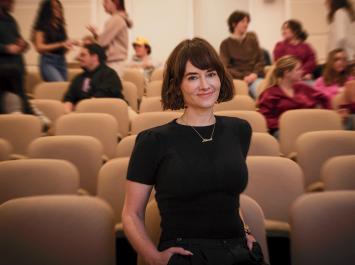Behind the Scenes: Group Mentality
Staff writer Max Krupnick shares his insights into what led him to professor of psychology Mina Cikara’s research on group behavior.
A few days after Hamas’s October 7 terrorist attack on Israel, I sat in my friend’s living room. We talked about our dismay with the state of the world. Hateful acts and rhetoric seemed so common and differences so entrenched. My friend is pursuing a Harvard doctorate in cognitive neuroscience, so he often interprets problems of politics as problems of the brain. I asked, is anyone in your department studying hatred? Is anyone trying to bridge communities, or understand why we fall apart? His answer: professor of psychology Mina Cikara, who has dedicated her career to examining how and why groups come into conflict.
Far from the Middle East, the story I chose to open with comes from Cikara’s graduate school days. Her now-husband was calmly chatting with one of her friends. But when the friend put on a Yankees hat, her boyfriend, a Red Sox loyalist, started bickering. This frivolous example sparked Cikara’s research. She saw that when we interact with each other person-to-person, we exist peacefully. But when we apply group labels, trouble brews.
I don’t think I would have uncovered that story just by reading Cikara’s papers. I interviewed her twice at length and talked with her departmental colleagues, former graduate students, past advisers, and husband. As a writer with no background in psychology, I relied on these interviews—far beyond what was necessary to complete the piece—to develop a deep understanding of her work. It’s because of donors like you that I can spend weeks interviewing extra sources and take the time to read a thick stack of Cikara’s papers at my slow, non-science pace. With that inside lens, I could see what aspects of her research were novel and impressive, and how her family story inspired her work.
In both this piece and my January-February feature on historian Myisha Eatmon, my subject’s research was intertwined with her life. Cikara became interested in intergroup conflict because she was raised by a Bosnian mother and a Serbian father, and the Yugoslav Wars clouded her childhood. But I did not want circumstances outside of her control to dominate the piece.
Balancing Cikara’s professional and personal narratives was not easy. In my first draft, I foregrounded her childhood, and when I wrote about her research, it was in such great detail that the lay reader lost sight of the piece’s goals. John Rosenberg, the editor, counseled me to start from scratch, put my notes away, and show the reader why Cikara’s research is so important. Donors like you give me the gift of time. The piece that emerged from those extra few weeks is much sharper and more interesting. Along with John, I want to thank my phenomenal editors—Jon Shaw, Lindsay Mitchell, and Lydialyle Gibson—for helping me balance Cikara’s life and work.
In these dark times, it would have been easy to focus on the pessimistic aspects of Cikara’s research. She studies schadenfreude—pleasure at other people’s pain—and just how easy it is to develop such hatred. But I wanted to highlight a hopeful arc. She writes that when we get to know people as individuals, their group membership becomes less important, and we are less likely to fall into hateful patterns. As I write at the end of the piece, even though her research reveals just how deeply humans are hardwired to form hostile groups, Cikara’s work could help us shape a better world.
